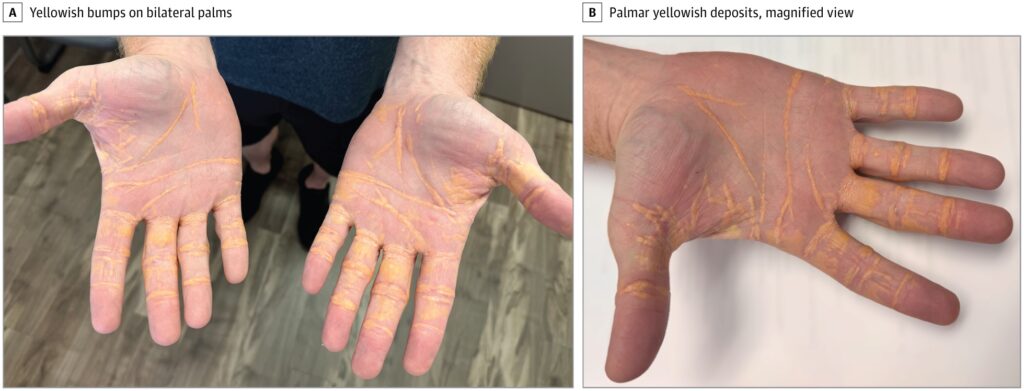Edit Content
Trending






Trees need a certain number of warm days in their growing seasons to grow properly; otherwise, the cell walls of new growth don’t lignify properly, creating blue rings that appear when wood samples are dyed.
Since trees and shrubs can live for hundreds of years, identifying these blue rings allows us to spot cold summers in the past. By looking at pine trees and juniper shrubs from northern Norway, scientists identified two extremely cold summers in 1902 and 1877, possibly caused by the eruptions of Mount Pelée on the island of Martinique and Cotopaxi in Ecuador.
“Blue rings look like unfinished growth rings, and are associated with cold conditions during the growing season,” said Dr. Agata Buchwal of Adam Mickiewicz University, Poland, lead author of the article in Frontiers in Plant Science.
“In general, we found more blue rings in trees than in shrubs. Shrubs seem to be more adapted to cooling events than trees, which is probably why shrubs are found further north. That is why I love to study shrubs; they seem to be the true heroes of the north.”
The scientists sampled cores from 25 Scots pine trees and stem-base disks from 54 common juniper shrubs at a site high on the treeline of Mount Iškoras in northern Norway. The team cross-sectioned and stained these samples, then photographed them under a microscope so that growth ring widths could be measured and cross-dated, and blue rings identified.
“Blue ring studies require a much longer protocol than classical dendrochronological studies,” Buchwal noted. “We are grateful to work with dedicated, highly-qualified lab technicians. Only together can we explore the blue ring world in high resolution using microscope slides.”
Overall, only 2.1% of the pine trees’ rings and 1.3% of the juniper shrubs’ rings were blue; the cells which hadn’t lignified properly were mainly found at the end of growth rings, in latewood.
Blue rings occurred most frequently in 1902—96% of pine trees and 68% of juniper shrubs—followed by 1877—84% of pine trees and 36% of juniper shrubs. Pine trees seemed to be more vulnerable to blue ring formation than juniper shrubs, which could make them a more sensitive indicator of cold summers.
“In the case of pine trees in boreal regions, blue rings have the potential to weaken the tree, making it more susceptible to mechanical damage or disease,” explained Dr. Pawel Matulewski of Adam Mickiewicz University, second author of the article. “If this phenomenon persists over several years, it can impede the tree’s recovery in following years.”
Comparing this data with local weather records showed that 1902 and 1877 were characterized by very low summer temperatures. In 1902, the coldest June ever recorded delayed the growing season, so a low total number of days in that year were warm enough for tree growth. This could explain why earlywood formed almost normally in 1902, but latewood didn’t, creating many blue latewood cells: the growing season was too short, so the latewood didn’t have time to develop properly.
Comparing the cooling events—the 1902 event fell in June, when the growth season usually begins, and the 1877 event in August—suggests it may even be possible to differentiate between cooling at different times. Late cooling events may lead to more lignified cell walls and a ‘less blue’ ring.
Discover the latest in science, tech, and space with over 100,000 subscribers who rely on Phys.org for daily insights.
Sign up for our free newsletter and get updates on breakthroughs,
innovations, and research that matter—daily or weekly.
Other studies have linked blue rings to global climatic events, such as cooling after large volcanic eruptions. 1902’s cold June could be related to the eruption of Mount Pelée in May.
Similarly, the late June eruption of Cotopaxi aligns with 1877’s cold August—but there is no other reported evidence for related cooling in northern Norway after this eruption. This blue ring could also be due to another, as-yet unidentified, factor.
Looking at other blue rings, the scientists identified more potential cold summer periods—but the weather seems to have been less cold, and some temperature data were missing, preventing analysis.
The scientists also caution that temperatures among the trees might have been different to those recorded at the Mount Iškoras weather station: future research will need in-situ weather data.
“We hope to inspire other research groups to look for the blue rings in their material,” said Buchwal. “It would be great to establish a blue ring network based on trees and shrubs to reconstruct cooling events at the northern treeline over long timescales.”
More information:
Blue rings in trees and shrubs as indicators of early and late summer cooling events at the northern treeline, Frontiers in Plant Science (2025). DOI: 10.3389/fpls.2024.1487099
Citation:
Curious blue rings in trees and shrubs reveal cold summers of the past—potentially caused by volcanic eruptions (2025, January 22)
retrieved 22 January 2025
from https://phys.org/news/2025-01-curious-blue-trees-shrubs-reveal.html
This document is subject to copyright. Apart from any fair dealing for the purpose of private study or research, no
part may be reproduced without the written permission. The content is provided for information purposes only.
©2024. Livebuzznews. All Rights Reserved.